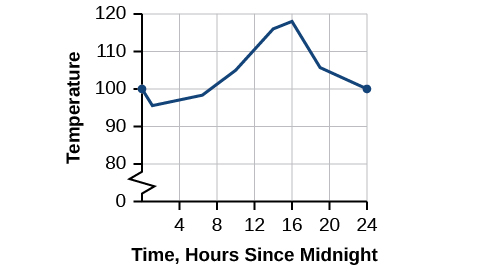
In this section, you will:
Arizona is known for its dry heat. On a particular day, the temperature might rise as high as
and drop down only to a brisk
[link] shows the function
where the output of
is the temperature in Fahrenheit degrees and the input
is the time of day, using a 24-hour clock on a particular summer day.

When we analyze this graph, we notice a specific characteristic. There are no breaks in the graph. We could trace the graph without picking up our pencil. This single observation tells us a great deal about the function. In this section, we will investigate functions with and without breaks.
Let’s consider a specific example of temperature in terms of date and location, such as June 27, 2013, in Phoenix, AZ. The graph in [link] indicates that, at 2 a.m., the temperature was
. By 2 p.m. the temperature had risen to
and by 4 p.m. it was
Sometime between 2 a.m. and 4 p.m., the temperature outside must have been exactly
In fact, any temperature between
and
occurred at some point that day. This means all real numbers in the output between
and
are generated at some point by the function according to the intermediate value theorem,
Look again at [link]. There are no breaks in the function’s graph for this 24-hour period. At no point did the temperature cease to exist, nor was there a point at which the temperature jumped instantaneously by several degrees. A function that has no holes or breaks in its graph is known as a continuous function. Temperature as a function of time is an example of a continuous function.
If temperature represents a continuous function, what kind of function would not be continuous? Consider an example of dollars expressed as a function of hours of parking. Let’s create the function
where
is the output representing cost in dollars for parking
number of hours. See [link].
Suppose a parking garage charges $4.00 per hour or fraction of an hour, with a $25 per day maximum charge. Park for two hours and five minutes and the charge is $12. Park an additional hour and the charge is $16. We can never be charged $13, $14, or $15. There are real numbers between 12 and 16 that the function never outputs. There are breaks in the function’s graph for this 24-hour period, points at which the price of parking jumps instantaneously by several dollars.
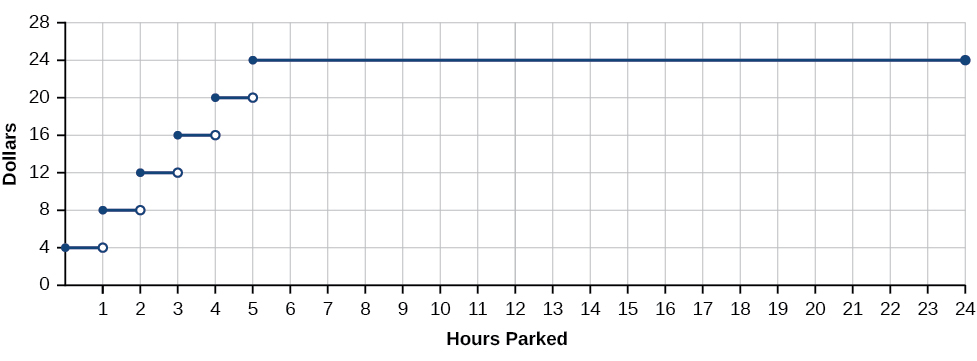
A function that remains level for an interval and then jumps instantaneously to a higher value is called a stepwise function. This function is an example.
A function that has any hole or break in its graph is known as a discontinuous function. A stepwise function, such as parking-garage charges as a function of hours parked, is an example of a discontinuous function.
So how can we decide if a function is continuous at a particular number? We can check three different conditions. Let’s use the function
represented in [link] as an example.
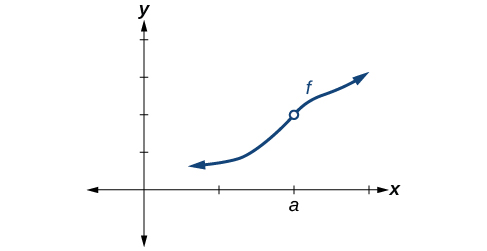
Condition 1 According to Condition 1, the function
defined at
must exist. In other words, there is a y-coordinate at
as in [link].
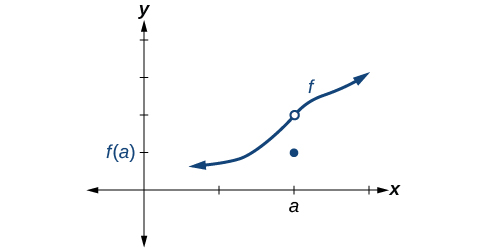
Condition 2 According to Condition 2, at
the limit, written
must exist. This means that at
the left-hand limit must equal the right-hand limit. Notice as the graph of
in [link] approaches
from the left and right, the same y-coordinate is approached. Therefore, Condition 2 is satisfied. However, there could still be a hole in the graph at
.
Condition 3 According to Condition 3, the corresponding
coordinate at
fills in the hole in the graph of
This is written
Satisfying all three conditions means that the function is continuous. All three conditions are satisfied for the function represented in [link] so the function is continuous as
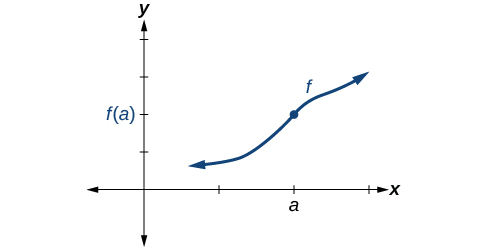
[link] through [link] provide several examples of graphs of functions that are not continuous at
and the condition or conditions that fail.
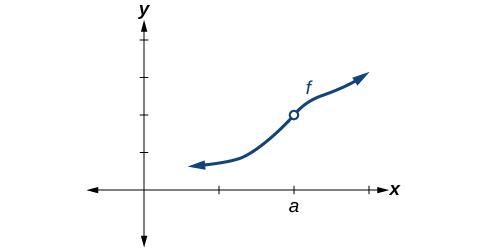
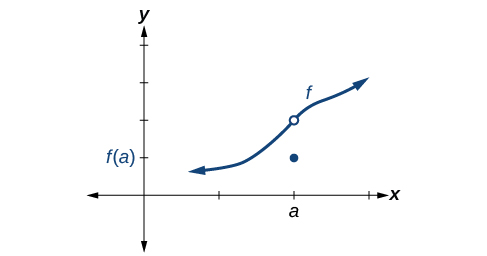
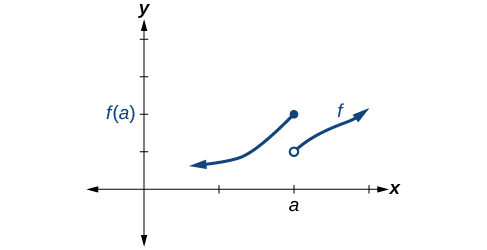
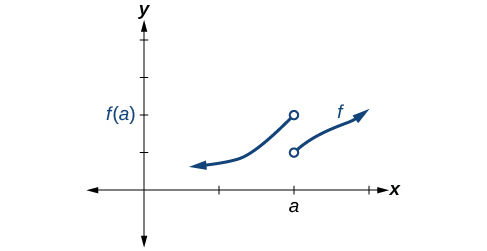
A function
is continuous at
provided all three of the following conditions hold true:
exists.
exists at
.
.
If a function
is not continuous at
the function is discontinuous at
.
Discontinuity can occur in different ways. We saw in the previous section that a function could have a left-hand limit and a right-hand limit even if they are not equal. If the left- and right-hand limits exist but are different, the graph “jumps” at
. The function is said to have a jump discontinuity.
As an example, look at the graph of the function
in [link]. Notice as
approaches
how the output approaches different values from the left and from the right.
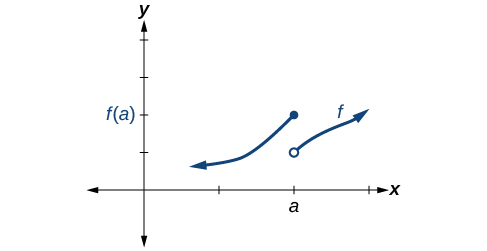
A function
has a jump discontinuity at
if the left- and right-hand limits both exist but are not equal:
.
Some functions have a discontinuity, but it is possible to redefine the function at that point to make it continuous. This type of function is said to have a removable discontinuity. Let’s look at the function
represented by the graph in [link]. The function has a limit. However, there is a hole at
. The hole can be filled by extending the domain to include the input
and defining the corresponding output of the function at that value as the limit of the function at
.
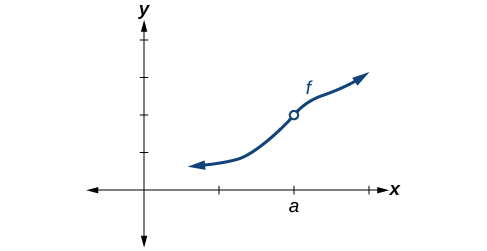
A function
has a removable discontinuity at
if the limit,
exists, but either
does not exist or
the value of the function at
does not equal the limit,
Identify all discontinuities for the following functions as either a jump or a removable discontinuity.
Notice that the function is defined everywhere except at
Thus,
does not exist, Condition 2 is not satisfied. Since Condition 1 is satisfied, the limit as
approaches 5 is 8, and Condition 2 is not satisfied.This means there is a removable discontinuity at
Condition 2 is satisfied because
Notice that the function is a piecewise function, and for each piece, the function is defined everywhere on its domain. Let’s examine Condition 1 by determining the left- and right-hand limits as
approaches 2.
Left-hand limit:
The left-hand limit exists.
Right-hand limit:
The right-hand limit exists. But
So,
does not exist, and Condition 2 fails: There is no removable discontinuity. However, since both left- and right-hand limits exist but are not equal, the conditions are satisfied for a jump discontinuity at
Identify all discontinuities for the following functions as either a jump or a removable discontinuity.
Many of the functions we have encountered in earlier chapters are continuous everywhere. They never have a hole in them, and they never jump from one value to the next. For all of these functions, the limit of
as
approaches
is the same as the value of
when
So
There are some functions that are continuous everywhere and some that are only continuous where they are defined on their domain because they are not defined for all real numbers.
The following functions are continuous everywhere:
| Polynomial functions | Ex: |
| Exponential functions | Ex: |
| Sine functions | Ex: |
| Cosine functions | Ex: |
The following functions are continuous everywhere they are defined on their domain:
| Logarithmic functions | Ex:, |
| Tangent functions | Ex:is an integer |
| Rational functions | Ex: |
Given a function
</math> determine if the function is continuous at
</math></strong>
exists.
exists at
If any one of the conditions is not satisfied, the function is not continuous at
Determine whether the function
is continuous at
To determine if the function
is continuous at
we will determine if the three conditions of continuity are satisfied at
.
Condition 1: Does
exist?
Condition 2: Does
exist?
To the left of
to the right of
We need to evaluate the left- and right-hand limits as
approaches 1.
Because
does not exist.
There is no need to proceed further. Condition 2 fails at
If any of the conditions of continuity are not satisfied at
the function
is not continuous at
Condition 1: Does
exist?
Condition 2: Does
exist?
To the left of
to the right of
We need to evaluate the left- and right-hand limits as
approaches
Because
exists,
Condition 3: Is
Because all three conditions of continuity are satisfied at
the function
is continuous at
Determine whether the function
is continuous at
yes
Determine whether the function
is continuous at
To determine if the function
is continuous at
we will determine if the three conditions of continuity are satisfied at
Condition 1:
There is no need to proceed further. Condition 2 fails at
If any of the conditions of continuity are not satisfied at
the function
is not continuous at
Determine whether the function
is continuous at
If not, state the type of discontinuity.
No, the function is not continuous at
There exists a removable discontinuity at
Now that we can identify continuous functions, jump discontinuities, and removable discontinuities, we will look at more complex functions to find discontinuities. Here, we will analyze a piecewise function to determine if any real numbers exist where the function is not continuous. A piecewise function may have discontinuities at the boundary points of the function as well as within the functions that make it up.
To determine the real numbers for which a piecewise function composed of polynomial functions is not continuous, recall that polynomial functions themselves are continuous on the set of real numbers. Any discontinuity would be at the boundary points. So we need to explore the three conditions of continuity at the boundary points of the piecewise function.
Given a piecewise function, determine whether it is continuous at the boundary points.
of the piecewise function, determine the left- and right-hand limits as
approaches
as well as the function value at
exists.
exists.
If any one of the conditions fails, the function is not continuous at
Determine whether the function
is discontinuous for any real numbers.
The piecewise function is defined by three functions, which are all polynomial functions,
on
on
and
on
Polynomial functions are continuous everywhere. Any discontinuities would be at the boundary points,
and
At
let us check the three conditions of continuity.
Condition 1:
Condition 2: Because a different function defines the output left and right of
does
Because
,
Condition 3:
Because all three conditions are satisfied at
the function
is continuous at
At
let us check the three conditions of continuity.
Condition 2: Because a different function defines the output left and right of
does
Because
,
so
does not exist.
Because one of the three conditions does not hold at
the function
is discontinuous at
See [link]. At
there exists a jump discontinuity. Notice that the function is continuous at
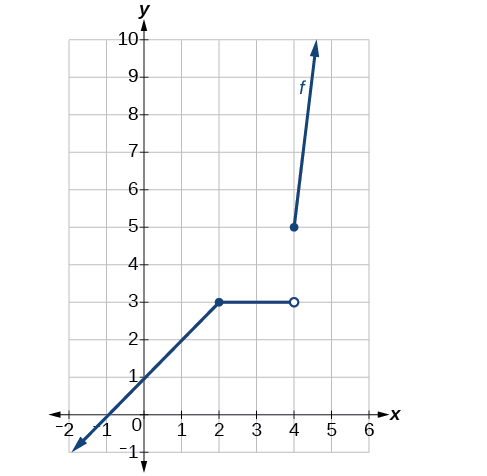
Determine where the function
is discontinuous.
To determine whether a piecewise function is continuous or discontinuous, in addition to checking the boundary points, we must also check whether each of the functions that make up the piecewise function is continuous.
Given a piecewise function, determine whether it is continuous.
of the piecewise function, determine if each of the three conditions hold.
Determine whether the function below is continuous. If it is not, state the location and type of each discontinuity.
The two functions composing this piecewise function are
on
and
on
The sine function and all polynomial functions are continuous everywhere. Any discontinuities would be at the boundary point,
At
let us check the three conditions of continuity.
Condition 1:
Because all three conditions are not satisfied at
the function
is discontinuous at
See [link]. There exists a removable discontinuity at
thus the limit exists and is finite, but
does not exist.
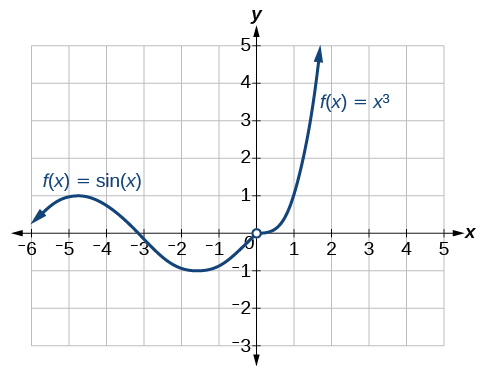
Access these online resources for additional instruction and practice with continuity.
exists.
exists at
State in your own words what it means for a function
to be continuous at
Informally, if a function is continuous at
then there is no break in the graph of the function at
and
is defined.
State in your own words what it means for a function to be continuous on the interval
For the following exercises, determine why the function
is discontinuous at a given point
on the graph. State which condition fails.
discontinuous at
;
does not exist
removable discontinuity at
;
is not defined
Discontinuous at
;
but
which is not equal to the limit.
does not exist.
. Therefore,
does not exist.
. Thus
does not exist.
,
Therefore,
does not exist.
is not defined.
is not defined.
is not defined.
For the following exercises, determine whether or not the given function
is continuous everywhere. If it is continuous everywhere it is defined, state for what range it is continuous. If it is discontinuous, state where it is discontinuous.
Continuous on
Continuous on
Discontinuous at
and
Discontinuous at
Continuous on
Continuous on
.
Continuous on
.
Determine the values of
and
such that the following function is continuous on the entire real number line.
For the following exercises, refer to [link]. Each square represents one square unit. For each value of
determine which of the three conditions of continuity are satisfied at
and which are not.

1, but not 2 or 3
1 and 2, but not 3
For the following exercises, use a graphing utility to graph the function
as in [link]. Set the x-axis a short distance before and after 0 to illustrate the point of discontinuity.
![Graph of the sinusodial function with a viewing window of [-10, 10] by [-1, 1].](../resources/CNX_Precalc_Figure_12_03_202F.jpg)
Which conditions for continuity fail at the point of discontinuity?
Evaluate
is undefined.
Solve for
if
What is the domain of
For the following exercises, consider the function shown in [link].
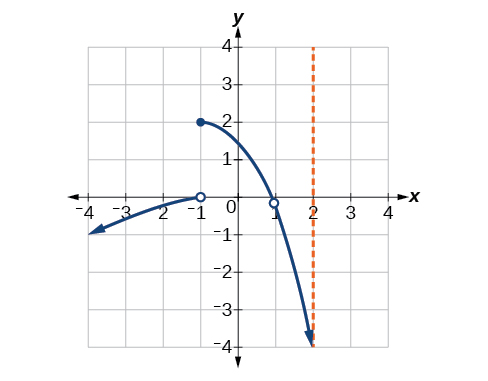
At what x-coordinates is the function discontinuous?
What condition of continuity is violated at these points?
At
the limit does not exist. At
does not exist.
At
there appears to be a vertical asymptote, and the limit does not exist.
Consider the function shown in [link]. At what x-coordinates is the function discontinuous? What condition(s) of continuity were violated?
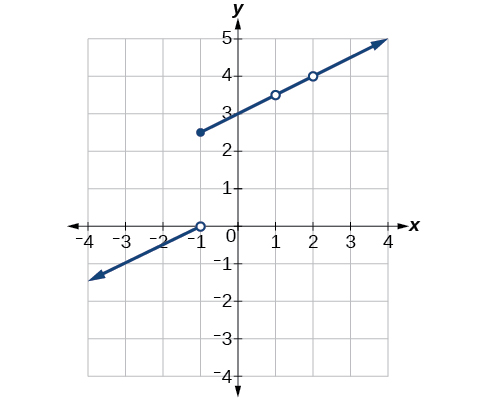
Construct a function that passes through the origin with a constant slope of 1, with removable discontinuities at
and
The function
is graphed in [link]. It appears to be continuous on the interval
but there is an x-value on that interval at which the function is discontinuous. Determine the value of
at which the function is discontinuous, and explain the pitfall of utilizing technology when considering continuity of a function by examining its graph.
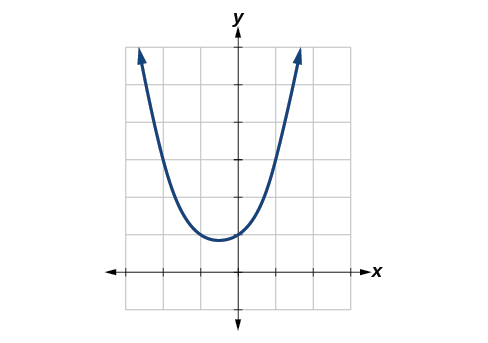
Find the limit
and determine if the following function is continuous at
The function is discontinuous at
because the limit as
approaches 1 is 5 and
at
where both the left and right-hand limits exist, but
where the function is discontinuous, but can be redefined to make it continuous

You can also download for free at http://cnx.org/contents/fd53eae1-fa23-47c7-bb1b-972349835c3c@8.1
Attribution: